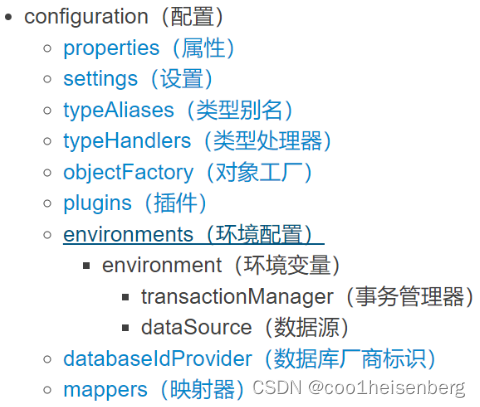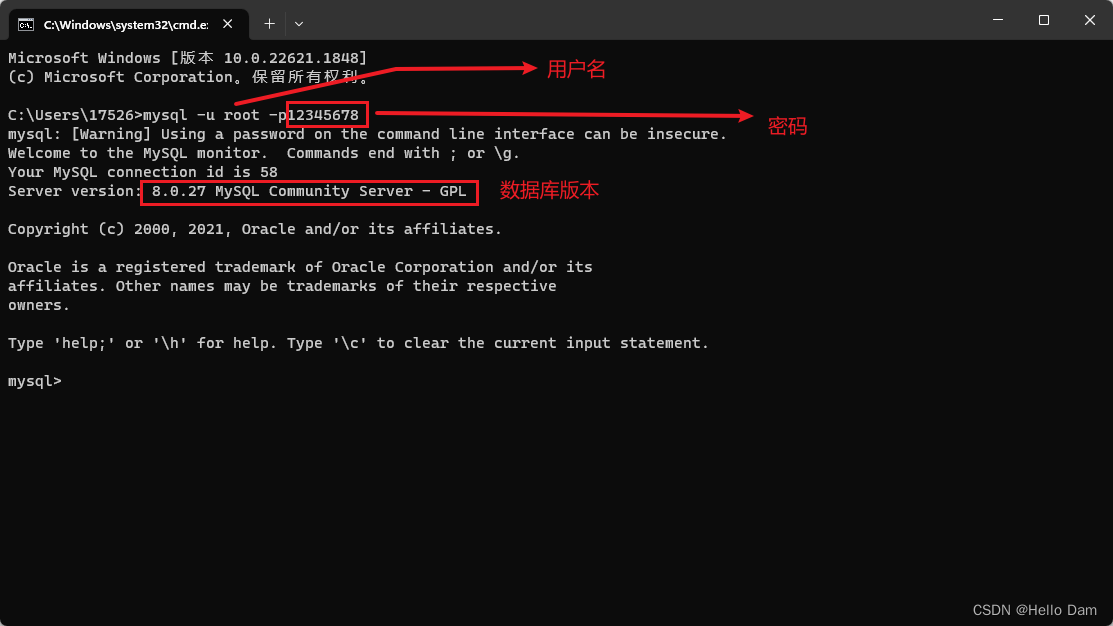03
文章目录
- 入门案例
- JDBC
- Mybatis
- Mybatis
- Mybatis介绍
- Mybatis的环境搭建
- 动态代理
- 增删改查示例
- 事务
- Mybatis的配置
- properties
- settings
- typeAliases
- environments
- mappers
- 输入映射
- 一个参数
- 多个参数
- 按位置传值
- 对象传值
- 使用Map进行传值
- #{}和${}的区别
- 输出映射
- 一个参数
- 多个参数
- 单个对象
- 多个对象
- resultMap
入门案例
JDBC
public class UserDaoImpl implements UserDao{ @Override public User selectByPrimaryKey(Integer id) throws Exception { // 1.获得连接,如果后面需要提交事务,则执行connection.commit Connection connection = JdbcUtil.getConnection(); // 2.预编译,预编译过程中传入了SQL语句 PreparedStatement preparedStatement = connection .prepareStatement("select id, username, password, age, birthday , create_date, mobile from cskaoyan_user where id = ?"); // 3.提供占位符位置的值 preparedStatement.setInt(1,id); // 4.执行查询获得结果集 ResultSet resultSet = preparedStatement.executeQuery(); // 5.创建一个接收结果集中的值的实例 User user = new User(); while (resultSet.next()) { // 6.获得结果集中的username列(column)中的值 String username = resultSet.getString("username"); // 获得结果集中的password列(column)中的值 String password = resultSet.getString("password"); int age = resultSet.getInt("age"); Date birthday = resultSet.getDate("birthday"); Date createDate = resultSet.getDate("create_date"); String mobile = resultSet.getString("mobile"); user.setId(id); // 7.通过set方法封装给user实例中的username这个成员变量(property) user.setUsername(username); // 通过set方法封装给user实例中的password这个成员变量(property) user.setPassword(password); user.setAge(age); user.setBirthday(birthday); user.setCreateDate(createDate); user.setMobile(mobile); } return user; } } //定义了UserDao接口,我们传入id,可以查询user的记录出来 public interface UserDao { User selectByPrimaryKey(Integer id) throws Exception; } // 假如我们定义了实现类,那么我们可以这样子来调用获得user记录 public class JdbcExecution { // 查询id为2的用户 public static void main(String[] args) throws Exception{ UserDao userDao = new UserDaoImpl(); User user = userDao.selectByPrimaryKey(2); System.out.println("user = " + user); } }这个过程比较繁琐,并且存在着很多定制化的内容和耦合
- SQL语句和代码直接耦合在一起
- 设置参数过程比较繁琐,对应的关系只有占位符的序号,如果有多个占位符?的话,容易出错
- 查询结果集的使用比较繁琐
- 手动调用构造方法来获得实例
- 要关注列名从结果集中取出数据
- 要关注列的类型手动调用不同的方法,比如getInt、getString、getDate
- 取出的值需要使用set方法来封装
Mybatis
- 导包
org.mybatis mybatis 3.5.10 mysql mysql-connector-java 5.1.47- 配置一个Mybatis的主配置文件,用来获取SqlSessionFactory
- 配置一个专门用来存放SQL语句的配置文件Mapper.xml
select * from account where id = #{id}- 实现
@Data public class User { Integer id; String name; Integer money; } public interface UserDao { public User selectUserById(Integer id); } /** * SqlSessionFactory:每一个Mybatis应用都是以SqlSessionFactory的实例对象为核心的。 * 使用Mybatis必须以SqlSessionFactory的实例为核心,再以SqlSessionFactory的实例生产SqlSession实例对象的。 * * SqlSession:这个其实表示和数据库之间的一个连接,里面封装了 Connection对象 */ public class UserImpl implements UserDao{ @Override public User selectUserById(Integer id){ // 在映射文件中的编号:usersql.selectById SqlSessionFactoryBuilder builder = new SqlSessionFactoryBuilder(); User user = null; try { InputStream inputStream = Resources.getResourceAsStream("mybatis.xml"); SqlSessionFactory sqlSessionFactory = builder.build(inputStream); // sql 会话,其实是对connection做了封装 SqlSession sqlSession = sqlSessionFactory.openSession(); // preparedStatement + setInt(1, id) + preparedStatement.executeQuery() // 然后将resultSet变成一个User实例 user = sqlSession.selectOne("userSql.selectById", id); } catch (IOException e) { e.printStackTrace(); } return user; } }在上面的案例中MyBatis做了什么事情:
- connection.preparedStatement需要传入的Sql语句,我们仅仅提供了坐标(映射文件的命名空间+id)
- 参数和占位符的对应关系,自动对应起来
- resultSet获得结果集,并且封装为User实例的过程完全是MyBatis自动完成的
Mybatis
Mybatis介绍
- Mybatis是一个基于Java的持久层框架
- Mybatis是一个ORM(Object Relationship Mapping)框架(对象关系映射框架)
- Mybatis就是一个可以帮助我们把关系型数据库中的记录转化为Java对象,把Java对象转化为关系型数据库中的记录的这么一个框架。
- 类和表之间的关系(eg:User类和test_user表之间的关系)
- 类中的成员变量和表中的列之间的关系(名称、JavaType和JdbcType)
- 数据库中的一条记录和Java中的一个实例(比如一个user对象和test_user中的一条记录)
- 它支持自定义 SQL、存储过程以及高级映射
- Mybatis 免除了几乎所有的 JDBC 代码以及设置参数和获取结果集的工作
- Mybatis 可以通过简单的XML或注解来配置和映射原始类型、接口和 Java POJO(Plain Old Java Objects,普通老式 Java 对象)为数据库中的记录
- Mybatis就是一个可以帮助我们在Java代码中更加高效的去操作数据库的一个框架
Mybatis的环境搭建
- 导包在pom.xml中
org.mybatis mybatis 3.5.9 mysql mysql-connector-java 5.1.47 junit junit 4.12- 配置MyBatis的主配置文件(mybatis-config.xml)
- 创建一个Java接口Mapper接口文件 (注意路径)
- 创建一个与Java接口文件对应的Mapper.xml配置文件
之后的步骤见上面的Mybatis的入门案例
动态代理
上面代码存在的一些不足:
- 目前Mybatis使用起来还不够灵活,不够简单。
- 虽然解决了SQL语句硬编码的问题,但是又出现了新的问题,SQL语句的坐标存在硬编码
- sqlSession调用的方法需要我们自己去指定,也就是UserDaoImpl中的内容还不够通用,我们想要进一步干掉它
而Mybatis的动态代理可以帮助我们去生成接口的代理对象,我们可以自己不实现接口。
eg:
public class MyBatisUtil { // 线程安全的值,可以全局共享 private static SqlSessionFactory sqlSessionFactory; static { try { sqlSessionFactory = new SqlSessionFactoryBuilder(). build(Resources.getResourceAsStream("mybatis.xml")); } catch (IOException e) { e.printStackTrace(); } } public static SqlSessionFactory getSqlSessionFactory() { return sqlSessionFactory; } } public class MybatisTest { @Test public void myTest() { // Mybatis生成的代理对象 -> 没有委托类 -> 只能从接口身上获得一些信息 /** * 获得接口的全限定类名 * 获得方法的数组 -> 方法的名称、返回值类型、参数的个数和类型 * 需要一个sql语句在映射文件中的坐标 -> 能否从上面选择一些信息保证组合起来的坐标是唯一的 * 坐标 = 接口的权限定类名 + 方法名(接口中的方法不允许重载) */ SqlSessionFactory sqlSessionFactory = MyBatisUtil.getSqlSessionFactory(); SqlSession sqlSession = sqlSessionFactory.openSession(); UserDao userDao = sqlSession.getMapper(UserDao.class); User user = userDao.selectUserById(2); System.out.println(user); } }/*不建议写select* */ select id,name,money from account where id = #{id}增删改查示例
insert into account(id, name, money) values (#{id}, #{name}, #{money}); update account set name = #{name} where id = #{id}; delete from account where id = #{id};对应接口:
int insertUser(User user); int updateUser(String name, Integer id); int deleteById(Integer id);
但是存在问题:Mybatis中openSession不提供事务的提交
事务
在使用Mybatis的时候, 自带事务,而且事务默认情况下是不会自动提交的
- 解决方法一:执行完SQL语句之后, 使用sqlSession提交事务
eg:sqlSession.commit();
- 解决办法二: 执行完SQL语句之后, 使用sqlSession内部封装的Connection 提交事务
eg:Connection conn = sqlSession.getConnection(); conn.commit();
- 解决办法三(自动提交) :在获得SqlSession的时候,给sqlSessionFactory.openSession设置为真
eg:SqlSession session = sqlSessionFactory.openSession(true);
Mybatis的配置
Mybatis的核心配置文件:
(这些标签都是有序的,按下面排序)
properties
properties表示可以外部配置的属性,并可以进行动态替换。(作为典型的是JDBC配置)
eg:
jdbc.properties文件中: driver=com.mysql.jdbc.Driver url=jdbc:mysql://localhost:3306/test_20240301?useSSL=false&userUnicode=true&characterEncoding=utf8 username=root password=123456
在Mybatis_config.xml中的内容为: .....settings
settings是MyBatis的行为配置(类似于idea和settings的关系)
eg:
日志的配置:
其它一些settings配置:
// 缓存 // 懒加载
typeAliases
typeAlies类型别名。(也就是我们可以对 类 起别名,简化操作) (暂时不建议使用)
eg:
则在Mapper.xml中的使用为:
// account == com.snow.www.bean.Account select * from account where id = #{id}environments
environments:可以配置成适应多种环境。比如开发环境、测试环境和生产环境等可能需要有不同的配置。
eg:
mappers
这个是映射器的配置。配置mapper.xml配置文件。
- 配置方式一:直接以对应mapper文件的相对路径
eg:
- 配置方式二:配置某个包下的所有的配置文件
eg:
输入映射
- 输入映射其实就是在说Mybatis是如何传值的
- 映射文件中的SQL语句中的语法:#{}里写什么东西,#{}这个位置最终在预编译的过程中变为了?
- 在Mapper接口中,方法的形参写了什么样式(个数、类型、注解),最终在映射文件中该方法对应的sql语句中的#{}应该如何写
一个参数
一个参数:(基本类型、包装类、String)
- #{任意值} 来取值: 不建议使用(显得不标准),建议使用注解写法
- 虽然一个参数的时候, 可以在{}内部任意书写参数名, 这种乱写行为不好, 不要这么写
eg:
select * from account where id = #{xxx}- 如果在方法中 的一个参数加了@Param注解,那么 后面就只能通过 #{注解值} 来取值
eg:
// 查找 public Account selectAccountById2(@Param("id") Integer id);select * from account where id = #{id}多个参数
多个参数:需要注解指明#{注解值} 来取值
-
- 直接写多个值,用参数名简单匹配是不识别的
-
- 如果参数名简单匹配是不识别,又不想加注解,也是有别的解决手段(按位传值: 不建议), 但是建议加注解(最标准的写法)
eg:
List selectListByIdOrName(@Param("id") Integer id,@Param("name") String name);select * from account where id = #{id} or name = #{name}按位置传值
按位传值:完全不建议(容易因为程序员的记忆和修改导致bug产生, 除非除了按位传值没办法了)
- 方式一::arg0、arg1、arg2...
- 下标从0开始
- 方式二:param1、param2、param3...
- 下标从1开始
eg:
userMapper.insertUser("zs", 18, "beijing");方式一: insert into `user` set `name`=#{arg0}, age=#{arg1}, address=#{arg2} 方式二: insert into `user` set `name`=#{param1}, age=#{param2}, address=#{param3}对象传值
- 方式一:SQL使用的参数命名要和对象内部属性保持一致 (#{成员变量名} 来取值)
eg:
// 对象传值,没有使用@Param注解,则是成员变量名 int insert1(User user);insert into account(id,name,money) values (#{id}, #{name} ,#{money})- 方式二:对象有注解,必须通过 #{注解值.成员变量名}来取值
eg:
// 对象传值,使用@Param注解,则是@Param写了什么就用什么 // user.money.... int insert2(@Param("user") User user);insert into account(id,name,money) values (#{user.id}, #{user.name}, #{user.money})使用Map进行传值
- 方式一:SQL使用的参数命名要和Map中存储数据的key保持一致 (#{key}来取值)
eg:
// Map map = new HashMap(); // map.put("id", 3); // map.put("name", "ss") // Map传值 --> 没有使用@Param注解 --> #{}里面写的是map的key:id和name int updateNameById(Map map);update account set name = #{name} where id = #{id}- 方式二:Map对象有注解, 必须通过#{注解值.key}来取值
eg:
// Map传值 --> 使用@Param注解 --> #{}里面写的是@Param注解的值 + map的key:map.id和map.name int updateNameById2(@Param("map") Map map);update account set name = #{map.name} where id = #{map.id}小结:
输入映射,Mybatis如何使用的user,通过get方法来使用。
#{}和${}的区别
- 使用${}做的就是字符串的拼接,如果传入的是字符串,需要在${}外围手动增加单引号``
- 核心点:使用${}有SQL注入的风险(SQL注入指:在执行的SQL语句之外额外执行一部分,导致信息泄露或者数据库被丢弃)
- 使用#{}过程是预编译,不会有SQL注入的风险
- #{参数}使用:预编译占位 (尽量使用 #{} ) PreparedStatement
eg:
insert into account(id,name,money) values (#{id}, #{name} ,#{money})/** * ==> Preparing: insert into account(id,name,money) values (?, ? ,?) * ==> Parameters: 6(Integer), ss(String), 8000(Integer) * Preparing: insert into account(id,name,money) values (5, `ws` ,`7000`) */
输出映射
- 输出映射一定和查询有关系,一定对应的是select标签
- 使用select标签一定使用和类型有关系的属性:
- resultType
- resultMap
- resultType中可以写别名
eg:
-- 只有1列,并且记录数为1条 → 查询user表中有多少条记录 -- 一个int或Integer类型的值来接收 select count(*) from account ; -- 只有一列,结果的记录数为多条 → 查询年龄为xxx的用户的名称 -- 数组或List、Set select name from account where age = 25; -- 多列,结果的记录数为1条 → 查询id为某个值的用户的全部信息 -- 引用类型对象 select id,name,money from account where id = 2; -- 多列,结果的记录数为多条 → 查询年龄为xxx的用户的全部信息 -- 引用类型对象的数组或List、Set select id,name,money from account where age = 25 ;
综上可得:
- 选择何种封装类型:取决于结果集中的列的个数,以及结果的记录数
- 封装最终体现在:落脚点在Mapper接口中的方法的返回值类型
一个参数
指的是:结果列为1且记录数为1(或0)
- 一个参数: 必须要有resultType(写简单参数的全限定名称或者是内置的别名)
eg:
// 单个列,结果记录数为1 int selectCount(); String selectNameById(Integer id);select count(*) from account; select name from account where id = #{id};多个参数
指的是:列只有一列,结果集中的记录数有多条(0或1条)
- 指: 多个参数构成的数组/List/Set
- 当我们返回多个简单参数的时候,在方法中定义的是数组就会返回数组,定义的是集合就会返回集合。
- xml中的标签配置不需要改变。并且, resultType的值是单个记录的类型
eg:
// 单个列,结果记录数为多条 // 按照不同的类型来封装,但是SQL语句是一样的 String[] selectNamesByMoney1(Integer money); List selectNamesByMoney2(Integer money); Set selectNamesByMoney3(Integer money);select name from account where money = #{money}; select name from account where money = #{money}; select name from account where money = #{money};单个对象
- 核心点:查询结果集中的列名 要和 对象中的成员变量名(set方法)相同
- 查询结果集中的列名可以通过as起别名的方式做修改
eg:
User selectAllMember(Integer id); User user = userMapper.selectAllMember(2);select * from account where id = #{id};多个对象
- 多个对象:数组/List/Set
- resultType的值是单个元素的类型
JDBC的封装举例:
ResultSet resultSet = prepareStatement.executeQuery(); List users = new ArrayList(); while(resultSet.next()){ User user = new User(); user.setUsername(resultSet.getString("username")); user.setPassword(resultSet.getString("password")); users.add(user); } //如果你需要一个Set可以在第2行这里定义为一个set ,也可以将这个List转为一个Set //如果你需要一个数组,也可以将这个List转为一个数组eg:
// 多个列,结果记录数为多条 User[] selectByAge1(@Param("age") Integer age); List selectByAge2(@Param("age") Integer age); Set selectByAge3(@Param("age") Integer age);select * from account where age = #{age} select * from account where age = #{age} select * from account where age = #{age}resultMap
- resultMap:是用来做参数映射的
- 存在这样的对应关系,我们才知道从结果集拿那一列的值(resultSet.getString("列名")),获得的值要封装给哪一个成员变量
- resultMap是可以复用的
eg:
UserVo selectUserVoByPrimaryKey(@Param("id") Integer id); UserVo userVo = userMapper.selectUserVoByPrimaryKey(2); System.out.println("userVo = " + userVo);select * from account where id = #{id};
- xml中的标签配置不需要改变。并且, resultType的值是单个记录的类型
- 一个参数: 必须要有resultType(写简单参数的全限定名称或者是内置的别名)
- 使用${}做的就是字符串的拼接,如果传入的是字符串,需要在${}外围手动增加单引号``
- 方式二:Map对象有注解, 必须通过#{注解值.key}来取值
- 方式一:SQL使用的参数命名要和Map中存储数据的key保持一致 (#{key}来取值)
- 方式二:对象有注解,必须通过 #{注解值.成员变量名}来取值
- 方式一:SQL使用的参数命名要和对象内部属性保持一致 (#{成员变量名} 来取值)
- 下标从1开始
-
- 如果在方法中 的一个参数加了@Param注解,那么 后面就只能通过 #{注解值} 来取值
- 虽然一个参数的时候, 可以在{}内部任意书写参数名, 这种乱写行为不好, 不要这么写
- #{任意值} 来取值: 不建议使用(显得不标准),建议使用注解写法
- 配置方式二:配置某个包下的所有的配置文件
- 配置方式一:直接以对应mapper文件的相对路径
- 解决方法一:执行完SQL语句之后, 使用sqlSession提交事务
- Mybatis就是一个可以帮助我们把关系型数据库中的记录转化为Java对象,把Java对象转化为关系型数据库中的记录的这么一个框架。
- 实现
- 配置一个专门用来存放SQL语句的配置文件Mapper.xml
- 配置一个Mybatis的主配置文件,用来获取SqlSessionFactory
- 导包



.png)









